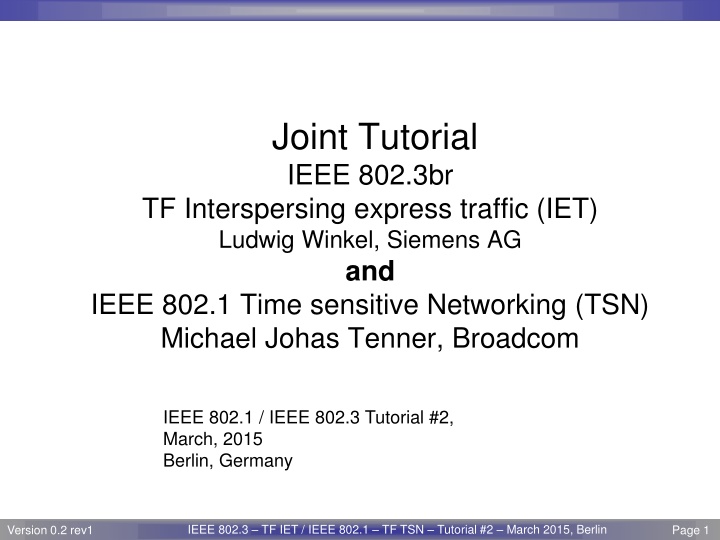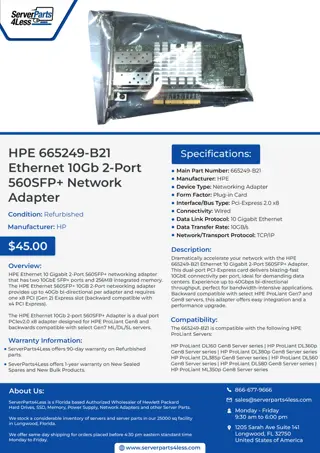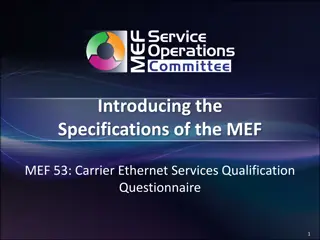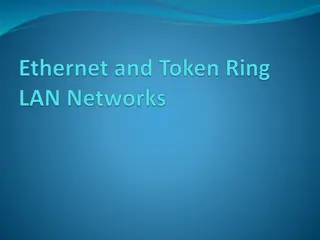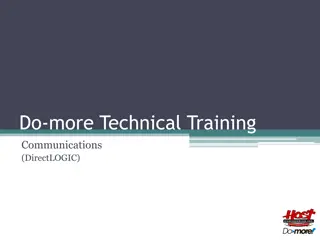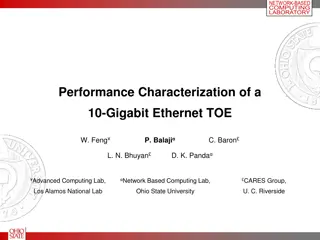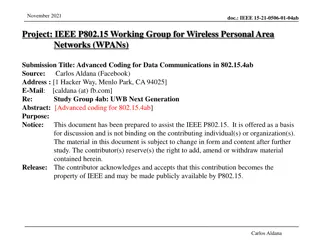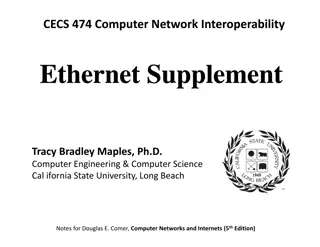Real-time Ethernet on IEEE 802.3 Networks Tutorial
This tutorial focuses on IEEE standards for real-time Ethernet networks, enabling deterministic delivery time for applications in industrial automation and automotive control. Key topics include IEEE 802.1 Time Sensitive Networking and P802.3br Interspersing Express Traffic projects, aiming to meet the requirements of various verticals by combining specialized standards with traditional traffic support.
Download Presentation

Please find below an Image/Link to download the presentation.
The content on the website is provided AS IS for your information and personal use only. It may not be sold, licensed, or shared on other websites without obtaining consent from the author.If you encounter any issues during the download, it is possible that the publisher has removed the file from their server.
You are allowed to download the files provided on this website for personal or commercial use, subject to the condition that they are used lawfully. All files are the property of their respective owners.
The content on the website is provided AS IS for your information and personal use only. It may not be sold, licensed, or shared on other websites without obtaining consent from the author.
E N D
Presentation Transcript
Joint Tutorial IEEE 802.3br TF Interspersing express traffic (IET) Ludwig Winkel, Siemens AG and IEEE 802.1 Time sensitive Networking (TSN) Michael Johas Tenner, Broadcom IEEE 802.1 / IEEE 802.3 Tutorial #2, March, 2015 Berlin, Germany IEEE 802.3 TF IET / IEEE 802.1 TF TSN Tutorial #2 March 2015, Berlin Version 0.2 rev1 Page 1
Title and presenters TITLE OF TUTORIAL: Real-time Ethernet on IEEE 802.3 Networks NAME OF PRESENTERS, THEIR AFFLIATIONS AND CONTACT INFO: Presenter(s) Name: Ludwig Winkel Michael J.Teener Norm Finn Pat Thaler Affiliation: Email Address: Siemens Broadcom Cisco Broadcom Ludwig.Winkel@Siemens.com mike@JOHASTEENER.COM nfinn@CISCO.COM pthaler@broadcom.com Panelists Siemens Hirschmann (Belden) b-plus GmbH Rockwell Automation Bosch albert.tretter@siemens.com Stephan.Kehrer@belden.com christian.boiger@b-plus.com ddbrandt@ra.rockwell.com Helge.Zinner@de.bosch.com Albert Tretter Stephan Kehrer Christian Boiger David Brandt Helge Zinner Version 1.0 Version 0.2 rev1 Page 2 Page 2 IEEE P802.3 Maintenance report July 2008 Plenary IEEE 802.3 TF IET / IEEE 802.1 TF TSN Tutorial #2 March 2015, Berlin
Abstract There have been multiple networks based on propriety technology or specialized standards developed to support carrying highly time sensitive traffic for applications such industrial automation and automotive control. Some of these are modified Ethernet networks. The efforts in IEEE 802.1 Time Sensitive Networking and P802.3br Interspersing Express Traffic provide an example of bringing together the requirements of those applications to provide a standard network that can support traffic requiring deterministic delivery time for real-time communication along with traditional traffic. This tutorial will cover the fundamentals of the projects and how they work together to fulfill the requirements of the various verticals. Version 1.0 Version 0.2 rev1 Page 3 Page 3 IEEE P802.3 Maintenance report July 2008 Plenary IEEE 802.3 TF IET / IEEE 802.1 TF TSN Tutorial #2 March 2015, Berlin
Agenda Welcome, Introduction (Michael, Ludwig) 5min Recap of Geneva Tutorial (Ludwig) 5min Project time lines (Michael, Ludwig) 5min Architectural Options/System Overview (Norm) 30min Enhancing IEEE 802.1Q tool set Interspersing Express Traffic (Pat) 30min Preemption for Ethernet Conclusion,Q&A/Discussion (Michael, Ludwig) 15min Version 1.0 Version 0.2 rev1 Page 4 Page 4 IEEE P802.3 Maintenance report July 2008 Plenary IEEE 802.3 TF IET / IEEE 802.1 TF TSN Tutorial #2 March 2015, Berlin
Recap of Geneva Tutorial Presented by Ludwig or Mike Version 1.0 Version 0.2 rev1 Page 5 Page 5 IEEE P802.3 Maintenance report July 2008 Plenary IEEE 802.3 TF IET / IEEE 802.1 TF TSN Tutorial #2 March 2015, Berlin
Potential Markets Served by IET Industrial Automation High Traffic Mix, Deterministic, Low Latency, Secure, Reliable, High Throughput Asset Optimization Version 1.0 Version 0.2 rev1 Page 6 Page 6 IEEE P802.3 Maintenance report July 2008 Plenary IEEE 802.3 TF IET / IEEE 802.1 TF TSN Tutorial #2 March 2015, Berlin
Control Function and Network Complexity Progression Virtualization Network Complexity Functional Complexity Network Fabrics Discrete Controls Era Networked Controls Era Functional Complexity Sensor/Actuator Networks Cloud Architecture Era Time Line 2013 Control Systems in all market sectors perpetually increase in functional complexity. Communications complexity limits functional capability. Advanced communications architectures enable advances in controls. Version 1.0 Version 0.2 rev1 Page 7 Page 7 IEEE P802.3 Maintenance report July 2008 Plenary IEEE 802.3 TF IET / IEEE 802.1 TF TSN Tutorial #2 March 2015, Berlin
Application Protocols for Control Motion Industrial Transportation Distribution Modbus TCP ARINC 664 IEC 61850 Ethercat SERCOS III OPC Flexray IEC 60870 AS6802 (TTE) Profinet DNP 3.0 Powerlink Foundation Fieldbus HSE Profinet IRT CAN SynqNet Ethernet/IP MOST IEEE 1588 NTP Note: There are many other proprietary protocols not on this list Version 1.0 Version 0.2 rev1 Page 8 Page 8 IEEE P802.3 Maintenance report July 2008 Plenary IEEE 802.3 TF IET / IEEE 802.1 TF TSN Tutorial #2 March 2015, Berlin
Why Converged Traffic Networks Minimizing Interference T2 T1 High low T2 Slot T1 Slot None time slotted traffic Time Cyclic Control Traffic Real time non cyclic Traffic Critical Alarms Discrete/event control None Real time Traffic Logging Alerting Version 1.0 Version 0.2 rev1 Page 9 Page 9 IEEE P802.3 Maintenance report July 2008 Plenary IEEE 802.3 TF IET / IEEE 802.1 TF TSN Tutorial #2 March 2015, Berlin
Why one single Network for all Communication Services Only one network means: - Reduced possibility of network failures - wire breaks, reduced confusion in case of maintenance - Reduced installation costs - fewer cables and connectors, lower installed costs and faster startups - Enables smaller devices - reduced space for connectors, lower power consumption (only half the number of PHYs needed) - Reduced maintenance costs - easier to understand and to maintain, less personnel training - Only one interface in the devices - only one MAC address, only one IP address, easier to understand and to maintain, easier coordination of the communication relations in the stack and application layer in the devices, more direct access to data. Version 1.0 Version 0.2 rev1 Page 10 Page 10 IEEE P802.3 Maintenance report July 2008 Plenary IEEE 802.3 TF IET / IEEE 802.1 TF TSN Tutorial #2 March 2015, Berlin
Summary: Industrial Requirements for Interspersed Traffic Performance requirements for Interspersed Traffic: Minimum latency: < 3 sec max per hop accumulated latency (GE min frame) Guaranteed latency, low jitter Topology independent Typical data size (payload size): 40 - 300 bytes Range of transmission period: 31.25 s 100ms and aperiodic Scheduled Traffic & Alarm has higher priority than Reserved Traffic and Best Effort Traffic Low cost, Low power, Low complexity * These are our best estimates derived from multiple use cases of the current and future industrial applications. Version 1.0 Version 0.2 rev1 Page 11 Page 11 IEEE P802.3 Maintenance report July 2008 Plenary IEEE 802.3 TF IET / IEEE 802.1 TF TSN Tutorial #2 March 2015, Berlin
Main Benefits of IET Better network utilization for scheduled traffic (More capacity). Lower latency for High Priority, critical asynchronous (non-scheduled) traffic. Lower cost and power consumption (for equivalent performance). Better environmental characteristics. Version 1.0 Version 0.2 rev1 Page 12 Page 12 IEEE P802.3 Maintenance report July 2008 Plenary IEEE 802.3 TF IET / IEEE 802.1 TF TSN Tutorial #2 March 2015, Berlin
Project time lines, Work plan Work plan IEEE 802-3br: TF review in Dec 2014 done WG ballot in March 2015 Publication in 1Q/2016 Work plan IEEE 802-1Qbu: TG review in Sep 2014 WG ballot in Jan 2015 Publication in Sep 2015 Version 1.0 Version 0.2 rev1 Page 13 Page 13 IEEE P802.3 Maintenance report July 2008 Plenary IEEE 802.3 TF IET / IEEE 802.1 TF TSN Tutorial #2 March 2015, Berlin
Architectural options / system overview Who, What, Why, How Norman Finn Version 1.0 Version 0.2 rev1 Page 14 Page 14 IEEE P802.3 Maintenance report July 2008 Plenary IEEE 802.3 TF IET / IEEE 802.1 TF TSN Tutorial #2 March 2015, Berlin
What is Time-Sensitive Networking? Same as normal networking, but with the following features for critical data streams: 1. Time synchronization for network nodes and hosts to better than 1 s. 2. Software for resource reservation for critical data streams (buffers and schedulers in network nodes and bandwidth on links), via configuration, management, and/or protocol action. 3. Software and hardware to ensure extraordinarily low packet loss ratios, starting at 10 6 and extending to 10 10 or better, and as a consequence, a guaranteed end-to-end latency for a reserved flow. 4. Convergence of critical data streams and other QoS features (including ordinary best-effort) on a single network, even when critical data streams are 75% of the bandwidth. Version 1.0 Version 0.2 rev1 Page 15 Page 15 IEEE P802.3 Maintenance report July 2008 Plenary IEEE 802.3 TF IET / IEEE 802.1 TF TSN Tutorial #2 March 2015, Berlin
Who needs Time-Sensitive Networking? Two classes of bleeding-edge customers, Industrial (including in-automobile) and Audio/Video. Both have moved into the digital world, and some are using packets, but now they all realize they must move to Ethernet, and most will move to the Internet Protocols. 1. Industrial: process control, machine control, and vehicles. At Layer 2, this is IEEE 802.1 Time-Sensitive Networking (TSN). Data rate per stream very low, but can be large numbers of streams. Latency critical to meeting control loop frequency requirements. 2. Audio/video: streams in live production studios. At Layer 2, this is IEEE 802.1 Audio Video Bridging (AVB). Not so many flows, but one flow is 3 Gb/s now, 12 Gb/s tomorrow. Latency and jitter are important, as buffers are scarce at these speeds. (You won t find any more market justification in this deck.) Version 1.0 Version 0.2 rev1 Page 16 Page 16 IEEE P802.3 Maintenance report July 2008 Plenary IEEE 802.3 TF IET / IEEE 802.1 TF TSN Tutorial #2 March 2015, Berlin
Why such a low packet loss ratio? Back-of-the-envelope calculations for big networks: 1. Industrial: Automotive factory floor: 1000 networks 10000 packets/s/network 100,000 s/day = 1012 packets/day. Machine fails safe when 2 consecutive packets of a stream are lost. At a random loss ratio of 10 6, 10 12 is chance of 2 consecutive losses. 1012 packets/day 10 12 2-loss ratio = 1 production line halt/day. In extreme cases, lost packets can damage equipment or require expensive measures to protect people. 2. Audio video production: (not distribution) 1010b/s 10 processing steps 1000 s/show = 1014 bits = 1010 packets. Waiting for ACKs and retries = too many buffers, too much latency. Lost packets result in a flawed master recording, which is the user s end product. Version 1.0 Version 0.2 rev1 Page 17 Page 17 IEEE P802.3 Maintenance report July 2008 Plenary IEEE 802.3 TF IET / IEEE 802.1 TF TSN Tutorial #2 March 2015, Berlin
How such a low packet loss ratio? 1. Zero congestion loss. This requires reserving resources along the path. (Think, IntServ and RSVP ) You cannot guarantee anything if you cannot say, No. This requires hardware in the form of buffers, shapers, and schedulers. Overprovisioning not useful: its packet loss curve has a tail. Circuits only scale by aggregation in to larger circuits. ( MPLS? Others?) 0 congestion loss goes hand-in-hand with finite guaranteed latency. 2. Seamless redundancy. 1+1 redundancy: Serialize packets, send on 2 (or more) fixed paths, then combine and delete extras. Paths are seldom automatically rerouted. 0 congestion loss means packet loss is failed equipment or cosmic rays. Zero congestion loss satisfies some customers without seamless redundancy. The reverse is not true in a converged network if there is congestion on one path, congestion is likely on the other path, as well. Version 1.0 Version 0.2 rev1 Page 18 Page 18 IEEE P802.3 Maintenance report July 2008 Plenary IEEE 802.3 TF IET / IEEE 802.1 TF TSN Tutorial #2 March 2015, Berlin
Why all the fuss? You could just Old-timers remember the fuss 1983-1995 about Ethernet vs. Token Bus, Token Ring, and other more deterministic versions of IEEE 802 wired media. Ethernet won. One could argue that this TSN stuff sounds like the same argument. So, what s different besides, That was then, this is now ? 1. TSN stays within the 802.1/802.3 paradigm. 2. Applications are more demanding of the network, now. 3. No IEEE 802 medium entirely captured the real-time control applications that drive the present effort they went to non-802 (including non-packet) answers. 4. Yes, Voice over IP works pretty well except when it doesn t. That s a non-starter for these users. 5. Too much data to overprovision. Version 1.0 Version 0.2 rev1 Page 19 Page 19 IEEE P802.3 Maintenance report July 2008 Plenary IEEE 802.3 TF IET / IEEE 802.1 TF TSN Tutorial #2 March 2015, Berlin
Queuing models Version 1.0 Version 0.2 rev1 Page 20 Page 20 IEEE P802.3 Maintenance report July 2008 Plenary IEEE 802.3 TF IET / IEEE 802.1 TF TSN Tutorial #2 March 2015, Berlin
The IEEE 802.1Q Queuing Model IEEE 802.1 has an integrated set of queuing capabilities. There are several capabilities, most familiar to all. The integrated part is important the interactions among these capabilities are well-characterized and mathematically sound. Version 1.0 Version 0.2 rev1 Page 21 Page 21 IEEE P802.3 Maintenance report July 2008 Plenary IEEE 802.3 TF IET / IEEE 802.1 TF TSN Tutorial #2 March 2015, Berlin
Priority queuing and weighted queuing 802.1Q-1998: Strict Priority 1 0 2 3 4 5 6 7 Priority selection 802.1Q-2012 (802.1Qaz) adds weighted queues. This standard provides standard management hooks for weighted priority queues without over-specifying the details. Weighted 1 0 2 3 4 5 6 7 Priority selection Version 1.0 Version 0.2 rev1 Page 22 Page 22 IEEE P802.3 Maintenance report July 2008 Plenary IEEE 802.3 TF IET / IEEE 802.1 TF TSN Tutorial #2 March 2015, Berlin
AVB shapers 802.1Q-2012 (802.1Qat) adds credit-based shapers . Shaped queues have higher priority than unshaped queues. The shaping still guarantees bandwidth to the highest unshaped priority (7). Highest priority for shaped queues Weighted 1 0 4 5 6 7 2 3 Priority selection The AVB shaper is similar to the typical run rate/burst rate shaper, but with really useful mathematical properties. Only parameter = bandwidth. The impact on other queues of any number of adjacent shapers Is the same as the impact of one shaper with the same total bandwidth. Version 1.0 Version 0.2 rev1 Page 23 Page 23 IEEE P802.3 Maintenance report July 2008 Plenary IEEE 802.3 TF IET / IEEE 802.1 TF TSN Tutorial #2 March 2015, Berlin
Time-gated queues 802.1Qbv: A circular schedule of {time, 8-bit mask} pairs controls gates between each queue and the priority selection function. Weighted 1 0 4 5 6 7 2 3 Operated by a repeating schedule T T T T T T T T Priority selection Version 1.0 Version 0.2 rev1 Page 24 Page 24 IEEE P802.3 Maintenance report July 2008 Plenary IEEE 802.3 TF IET / IEEE 802.1 TF TSN Tutorial #2 March 2015, Berlin
Cyclic Queuing and Forwarding 802.1Qch: The 1Qbv time gated queues are used to create double buffers (two pairs, 2 3 and 4 5, shown in this example) Shapers ensure fair access for 0, 1, 6, 7 traffic 1 0 6 7 2 3 4 5 Alternately enable green and purple T T T T T T T T Priority selection If the wire length and bridge transit time are negligible compared to the cycle time, double buffers are sufficient. Frames being received Dead-time pad For next cycle Output in progress Version 1.0 Version 0.2 rev1 Page 25 Page 25 IEEE P802.3 Maintenance report July 2008 Plenary IEEE 802.3 TF IET / IEEE 802.1 TF TSN Tutorial #2 March 2015, Berlin
Security and misbehavior Security has traditionally been concerned with Privacy: Hiding the data from intruders Authentication: Ensuring that the data is not altered. But now, proper operation depends upon the transmission timing, as well as the contents, of a packet. The only difference between a malicious intruder and a software bug, misconfiguration, or hardware failure is intent, not result. For example, a babbling idiot sending extra data on a TSN priority can cause the loss of packets from properly-behaving flows that share the same output queue. Therefore, defense in depth is required to protect the network. Version 1.0 Version 0.2 rev1 Page 26 Page 26 IEEE P802.3 Maintenance report July 2008 Plenary IEEE 802.3 TF IET / IEEE 802.1 TF TSN Tutorial #2 March 2015, Berlin
Per-stream filtering and policing Applies to frames coming up the stack, not down. G G G G G G G G G G G Priority + circuit_identifier demux The priority and packet flow ID (circuit_identifier) select to which Gate a frame is directed in P802.1Qci. Each Gate can have: 1. A pass / don t pass switch. (May be time scheduled) 2. A standard 802.1Q policing function. 3. Counters of frames: e.g. passed, marked down, and discarded. 4. A Service Class or priority output specifyer (TBD) 5. Filters, e.g. max frame size. IEEE 802.3 TF IET / IEEE 802.1 TF TSN Tutorial #2 March 2015, BerlinG 0 0 1 0 0 1 P 0 0 1 0 0 1 Version 1.0 Version 0.2 rev1 Page 27 Page 27 IEEE P802.3 Maintenance report July 2008 Plenary
Interspersed Express Traffic Preempting a non-time-critical frame with a low-latency frame does get the low-latency frame out, sooner. But, in many networks of interest, there are many conflicting low- latency frames and the preemption of the non-time-critical frame only helps the first one. Scheduling the time-critical frames transmission (P802.1Qbv) gives almost 0 jitter and guarantees end-to-end latency. These scheduled transmissions are the rocks around which a time- critical application is built. Version 1.0 Version 0.2 rev1 Page 28 Page 28 IEEE P802.3 Maintenance report July 2008 Plenary IEEE 802.3 TF IET / IEEE 802.1 TF TSN Tutorial #2 March 2015, Berlin
Interspersed Express Traffic IET is critical for convergence; non-scheduled does not mean unimportant . Scheduled rocks of critical packets in each cycle: Conflict excessively with non-guaranteed packet rocks: 1 2 2 2 Problem solved by preemptive sand between the rocks. 3 3 1 2 Version 1.0 Version 0.2 rev1 Page 29 Page 29 IEEE P802.3 Maintenance report July 2008 Plenary IEEE 802.3 TF IET / IEEE 802.1 TF TSN Tutorial #2 March 2015, Berlin
But wait! Theres more! As a consequence of the above, you also get Cut-through forwarding: The scheduling tools mentioned, above, allow one to guarantee scheduled cut-through forwarding opportunities for predictable ultra-low-latency packets. Intentional buffering delays: Time-scheduled transmissions can intentionally delaying transmissions in order to guarantee both a minimum and a maximum latency, thus minimizing jitter for the critical traffic. Industrial systems that trigger events based on packet reception require this. Version 1.0 Version 0.2 rev1 Page 30 Page 30 IEEE P802.3 Maintenance report July 2008 Plenary IEEE 802.3 TF IET / IEEE 802.1 TF TSN Tutorial #2 March 2015, Berlin
Current IEEE 802 Status Version 1.0 Version 0.2 rev1 Page 31 Page 31 IEEE P802.3 Maintenance report July 2008 Plenary IEEE 802.3 TF IET / IEEE 802.1 TF TSN Tutorial #2 March 2015, Berlin
IEEE 802 standards now and coming 802.1 Audio Video Bridging is now the Time-Sensitive Networking TG. Time: A plug-and-play Precision Time Protocol (PTP) profile that allow bridges, routers, or multi-homed end stations to serve as time relays in a physical network, regardless of L2/L3 boundaries. (1AS complete, 1ASbt improvements in TG ballot) Reservation: A protocol (MSRP) to reserve bandwidth along an L2 path determined by L2 topology protocol, e.g. ISIS. (1Qat complete, 1Qcc enhancements in TG ballot) Execution: Several kinds of resources (shapers, schedulers, etc.) that can be allocated to realize the promises made by the reservation. (See next slides.) Path distribution: ISIS TLVs to compute and distribute multiple paths through a network. (1Qca in sponsor ballot) Seamless Redundancy: 1+1 duplication for reliability. (1CB in TG ballot) Version 1.0 Version 0.2 rev1 Page 32 Page 32 IEEE P802.3 Maintenance report July 2008 Plenary IEEE 802.3 TF IET / IEEE 802.1 TF TSN Tutorial #2 March 2015, Berlin
IEEE 802 schedulers and shapers AVB Credit-Based Shaper: Similar to the typical run rate/burst rate shaper, but with really useful mathematical properties. (1Qat done) Only parameter = bandwidth. The impact of any number of shapers = the impact of one shaper with the same total bandwidth. Transmission preemption / express forwarding: Interrupt (1 level only) transmission of an Ethernet frame with a frame with tight latency requirements, then resume the interrupted frame. (3br, 1Qbu TG ballot) Time scheduled: Every bridge port runs a synchronized, repeating schedule that turns on and off each of the 8 queues with up to nanosecond precision. (1Qbv WG ballot) Synchronized Queuing and Forwarding: Every flow proceeds in lock-stepped transmission cycles, like arterial blood. (1Qch PAR approval) Per-Stream Filtering and Policing: Packets accepted only from the right port only at the right time or at the right rate. (1Qci PAR approval) Version 1.0 Version 0.2 rev1 Page 33 Page 33 IEEE P802.3 Maintenance report July 2008 Plenary IEEE 802.3 TF IET / IEEE 802.1 TF TSN Tutorial #2 March 2015, Berlin
Mixed L2/L3 need Version 1.0 Version 0.2 rev1 Page 34 Page 34 IEEE P802.3 Maintenance report July 2008 Plenary IEEE 802.3 TF IET / IEEE 802.1 TF TSN Tutorial #2 March 2015, Berlin
Reference network As seen by network topology protocols Controller Physical connectivity Network sizes vary from ~home to ~large but within one administrative domain. Listener La L2 Talker Lc L2 T MultiLink subnet L2 L3 routers Ld Lb Bridges Gazillions of complex protocols Version 1.0 Version 0.2 rev1 Page 35 Page 35 IEEE P802.3 Maintenance report July 2008 Plenary IEEE 802.3 TF IET / IEEE 802.1 TF TSN Tutorial #2 March 2015, Berlin
Reference network As seen by reliability/ queuing/latency/time Listener X Physical connectivity Queue Clock La Talker Lc T Ld Lb Just nodes, queues, clocks, and wires!! Version 1.0 Version 0.2 rev1 Page 36 Page 36 IEEE P802.3 Maintenance report July 2008 Plenary IEEE 802.3 TF IET / IEEE 802.1 TF TSN Tutorial #2 March 2015, Berlin
Summary By means of resource reservation, via protocol, configuration, or net management, time-critical traffic can be guaranteed a low, finite end-to-end latency and extraordinarily low loss rate. Preemption enables these guarantees to be made without sacrificing the ability of the network to carry ordinary traffic, and without compromising the promises made to time-critical traffic. These features can, and should, work irrespective of L2/L3 boundaries, though of course, proper layering must be respected. Version 1.0 Version 0.2 rev1 Page 37 Page 37 IEEE P802.3 Maintenance report July 2008 Plenary IEEE 802.3 TF IET / IEEE 802.1 TF TSN Tutorial #2 March 2015, Berlin
Interspersing Express Traffic Preemption for Ethernet Pat Thaler Version 1.0 Version 0.2 rev1 Page 38 Page 38 IEEE P802.3 Maintenance report July 2008 Plenary IEEE 802.3 TF IET / IEEE 802.1 TF TSN Tutorial #2 March 2015, Berlin
IET Architecture MAC Merge sublayer Capability discovery without negotiation Preserves frame integrity Is transparent to existing non- deprecated PHYs above 10 Mb/s Doesn t change MAC operation Minimizes impact on throughput Provides lower latency for express traffic Provides cut-through for scheduled traffic Queuing Frames Transmission Selection MAC Control MAC Control Express MAC Preemptable MAC MAC Merge Sublayer PHY (unaware of preemption) Version 1.0 Version 0.2 rev1 Page 39 Page 39 IEEE P802.3 Maintenance report July 2008 Plenary IEEE 802.3 TF IET / IEEE 802.1 TF TSN Tutorial #2 March 2015, Berlin
MAC Merge Sublayer Version 1.0 Version 0.2 rev1 Page 40 Page 40 IEEE P802.3 Maintenance report July 2008 Plenary IEEE 802.3 TF IET / IEEE 802.1 TF TSN Tutorial #2 March 2015, Berlin
MAC Merge sublayer Express MAC (eMAC) Premptable MAC (pMAC) Express Filter Verification Receive Processing Transmit Processing Physical Layer Transmit processing arbitrates between eMAC and pMAC transmit packets and preempts if preemption capability is active. Express filter sends express packets to eMAC Receive Processing handles mPacket formats, checks fragments and sends to pMAC Verification tests that the link can support preemption before preemption is activated Version 1.0 Version 0.2 rev1 Page 41 Page 41 IEEE P802.3 Maintenance report July 2008 Plenary IEEE 802.3 TF IET / IEEE 802.1 TF TSN Tutorial #2 March 2015, Berlin
Preemption capability disabled Transmit Processing Express Filter Receive Processing Verification Transmit processing eMAC packets have priority over pMAC packets They don t preempt but if both have a frame ready to start, eMAC packet is sent. Preemptable mPacket formats aren t used Able to receive preemptable mPackets from link partner If link partner preemption capability isn t active, all packets received by eMAC Verification will respond to verify request from link partner Version 1.0 Version 0.2 rev1 Page 42 Page 42 IEEE P802.3 Maintenance report July 2008 Plenary IEEE 802.3 TF IET / IEEE 802.1 TF TSN Tutorial #2 March 2015, Berlin
Preemption enabled, not active Transmit Processing Express Filter Receive Processing Verification Verification function attempts to verify link preemption capability Transmits a verify mPacket Receipt of a response mPacket verifies the link and preemption capability can go active. No change to Express Filter, Receive Processing or Transmit Processing Version 1.0 Version 0.2 rev1 Page 43 Page 43 IEEE P802.3 Maintenance report July 2008 Plenary IEEE 802.3 TF IET / IEEE 802.1 TF TSN Tutorial #2 March 2015, Berlin
Why verify? A link partner s preemption capability is discovered through LLDP, IEEE 802.1Q bridges don t forward if the SA is nearest bridge group address, but Some non-standard devices (e.g. buffered repeaters) don t block the address. If such a device is between two ports, it may drop or alter the preemptable mPackets. Verify tests that the link between to ports is able to carry preemptable mPacket formats. Networks that are fixed by design (e.g. automotive networks) can disable verification. Version 1.0 Version 0.2 rev1 Page 44 Page 44 IEEE P802.3 Maintenance report July 2008 Plenary IEEE 802.3 TF IET / IEEE 802.1 TF TSN Tutorial #2 March 2015, Berlin
Preemption Active Transmit Processing Express Filter Receive Processing Verification mPackets Transmit processing Uses mPacket formats Preempts preemptable packets if eMAC has a packet to send or for a HOLD request. Verification responds to verify requests Version 1.0 Version 0.2 rev1 Page 45 Page 45 IEEE P802.3 Maintenance report July 2008 Plenary IEEE 802.3 TF IET / IEEE 802.1 TF TSN Tutorial #2 March 2015, Berlin
Discovery and verification summary Preemption capability independently activated on each end. Capability discovery not negotiation. Receiver is always ready for preemption Receive Processing and Express Filter behavior is the same regardless of whether preemption capability is active. Link ability to support preemption is verified Version 1.0 Version 0.2 rev1 Page 46 Page 46 IEEE P802.3 Maintenance report July 2008 Plenary IEEE 802.3 TF IET / IEEE 802.1 TF TSN Tutorial #2 March 2015, Berlin
MAC Merge Service Interface Minimizing latency for scheduled traffic Version 1.0 Version 0.2 rev1 Page 47 Page 47 IEEE P802.3 Maintenance report July 2008 Plenary IEEE 802.3 TF IET / IEEE 802.1 TF TSN Tutorial #2 March 2015, Berlin
Without Hold and Release pMAC tx eMAC tx > Min mPacket left MAC Merge tx IPG Preemption isn t instantaneous. Packets with less than min packet size left to transmit or packets less than 123 octets can t be preempted. In many use cases, this delay is short enough but not in all cases. Version 1.0 Version 0.2 rev1 Page 48 Page 48 IEEE P802.3 Maintenance report July 2008 Plenary IEEE 802.3 TF IET / IEEE 802.1 TF TSN Tutorial #2 March 2015, Berlin
MMSI Hold and Release MAC Merge Service Interface primitive: Primitive from the MAC Client to MAC Merge sublayer MM_CTL.request (hold_req) hold_req takes one of 2 values: HOLD, RELEASE hold stops transmission from the pMAC preempting if preemption capability is active release allows pMAC transmission. Version 1.0 Version 0.2 rev1 Page 49 Page 49 IEEE P802.3 Maintenance report July 2008 Plenary IEEE 802.3 TF IET / IEEE 802.1 TF TSN Tutorial #2 March 2015, Berlin
With Hold and Release MAC Client schedule Guard band Express traffic window MM_CTL.request HOLD RELEASE pMAC tx eMAC tx > Min mPacket left MAC Merge tx IPG Asserting MM_CTL.request (HOLD) a guardband in advance of a scheduled express traffic window ensures minimal latency (cut- through) for express traffic Version 1.0 Version 0.2 rev1 Page 50 Page 50 IEEE P802.3 Maintenance report July 2008 Plenary IEEE 802.3 TF IET / IEEE 802.1 TF TSN Tutorial #2 March 2015, Berlin
